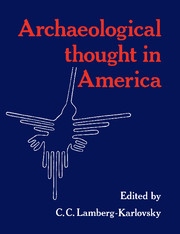Book contents
- Frontmatter
- Contents
- List of illustrations
- Introduction
- Part I History, method, and theory
- Part II Archaeology in the Americas and beyond
- 9 The structural analysis of Paleolithic art
- 10 Ancient China and its anthropological significance
- 11 Settlement pattern studies and evidences for intensive agriculture in the Maya Lowlands
- 12 The political economy of the Inka empire: the archaeology of power and finance
- 13 An epigenetic view of the Harappan culture
- 14 The use and abuse of world systems theory: the case of the “pristine” West Asian state
- 15 Mesopotamia, Central Asia and the Indus Valley: so the kings were killed
- 16 New tracks on ancient frontiers: ceramic technology on the Indo-Iranian Borderlands
- 17 Pastoralism and the early state in Greater Mesopotamia
- References
- Index
9 - The structural analysis of Paleolithic art
Published online by Cambridge University Press: 06 July 2010
- Frontmatter
- Contents
- List of illustrations
- Introduction
- Part I History, method, and theory
- Part II Archaeology in the Americas and beyond
- 9 The structural analysis of Paleolithic art
- 10 Ancient China and its anthropological significance
- 11 Settlement pattern studies and evidences for intensive agriculture in the Maya Lowlands
- 12 The political economy of the Inka empire: the archaeology of power and finance
- 13 An epigenetic view of the Harappan culture
- 14 The use and abuse of world systems theory: the case of the “pristine” West Asian state
- 15 Mesopotamia, Central Asia and the Indus Valley: so the kings were killed
- 16 New tracks on ancient frontiers: ceramic technology on the Indo-Iranian Borderlands
- 17 Pastoralism and the early state in Greater Mesopotamia
- References
- Index
Summary
Introduction
This chapter is about the application of structuralist ideas to the study of a particular archaeological phenomenon that we have labeled “Paleolithic art.” It is ambitious to take on structuralism in general in a single chapter. Although some general background on structuralism is presented, I will focus on structuralist approaches in Paleolithic art, particularly that of Leroi-Gourhan (e.g. 1965, 1972), who elucidated what he believed to be a set of underlying structural or generative principles for the making and placing of specific images on cave walls. It is thoroughly appropriate to consider structuralist perspectives in the archaeology of the Upper Paleolithic because a pioneering structuralist analysis in archaeology as a whole is widely recognized to have been this work of Leroi-Gourhan. Furthermore, this study, which will be considered below, remains one of the more extensive applications of structuralism to archaeological data, particularly from a prehistoric (as contrasted with historic) context.
The object of structural analysis that is being considered here is “Paleolithic art.” By this term we refer to an amazingly wide and diverse range of imagery and material culture: geometrically incised bone and antler implements; pieces of bone and antler with representational imagery (often animals); carved or sculpted images – in bone, stone, antler, ivory – that include humans and animals; bas-reliefs on stone blocks; engravings on cave walls or plaquettes of stone – sometimes hundreds of images overlain in a single ‘panel’ or space; and perhaps the most famous imagery – the paintings or drawings on cave walls.
- Type
- Chapter
- Information
- Archaeological Thought in America , pp. 135 - 154Publisher: Cambridge University PressPrint publication year: 1989
- 18
- Cited by



